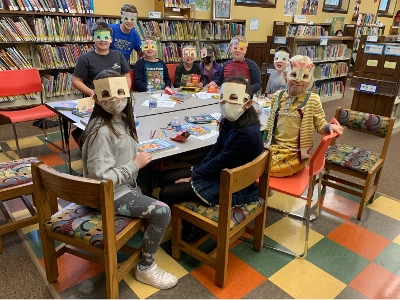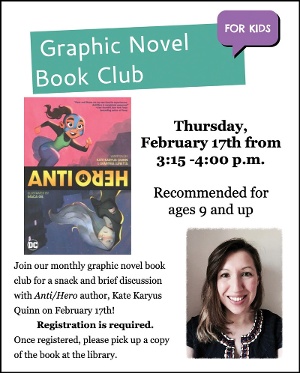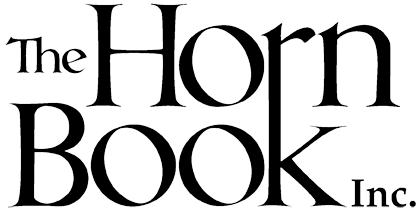Field Notes: Hosting a Middle-Grade Graphic Novel Club
Graphic novels are everywhere nowadays, and for good reason. Their narrative style offers many entry points for readers: they can be colorful, visually engaging, often diverse, and enjoyable. Some publishers have launched imprints devoted to them, strengthening commitment to the category’s future and giving librarians more opportunities to cheerlead, share, and discuss them. Book clubs are a great place to start.
I host a middle-grade graphic novel club at my small public library. We offer the club to third- through sixth-grade children. The capacity is twelve, and registration is required for the sake of statistics and supplies. We meet once a month after school.
These often joyful, always thought-provoking gatherings develop kids’ social and emotional skills by playfully creating community, encouraging mental flexibility and critical thinking, and allowing children to express themselves and listen patiently while others speak. As librarians, we want to help children develop these executive function skills to support them in becoming healthy, happy, and productive adults (as I learned from studying the importance of storytime with Mother Goose on the Loose creator Dr. Betsy Diamant-Cohen).

When I took over the library’s club in 2021, I wasn’t particularly keen on novels in comic format. I had nothing against them. As a nineties kid, I just didn’t have them on my radar. While I investigated middle-grade graphic lit, I realized there wasn’t much information on how to keep such a club going—so I learned the hard way.
As I explored the format more, I saw how graphic novels could build reading confidence and stamina while developing a deeper appreciation of storytelling. Graphic novels also foster a love for reading, ignite the imagination with visually engaging stories, and present complex narratives and themes that encourage further thought. However, seeing the enthusiasm in the eyes of my young readers was all I needed to get onboard.
At our first gathering, I polled the kids to find out what graphic novels and series they already loved—Dog Man, The Baby-Sitters Club, Big Nate. Knowing their interests helped me determine what they might want to read next. I started scouring book review journals and noting potential picks as they became available. However, the books chosen for the club can’t be brand-new; otherwise, there won’t be enough copies available via interlibrary loan.
Some Titles We've Read
Awkward (Yen Press, 2015) by Svetlana Chmakova
Miss Quinces (Graphix/Scholastic) by Kat Fajardo; color by Marian Azzi
InvestiGators (First Second, 2020) by John Patrick Green
Ride On (First Second, 2022) by Faith Erin Hicks
Pawcasso (Holt, 2021) by Remy Lai
Ham Helsing #1: Vampire Hunter (Crown, 2021) by Rich Moyer
Four Eyes (Scholasti, 2023) by Rex Ogle; illus. by Dave Valeza; color by Ash Szymanik
Garlic & the Witch (Quill Tree/HarperCollins, 2022) by Bree Paulsen
Anti/Hero (DC Comics, 2020) by Kate Karyus Quinn and Demitria Lunetta; illus. by Maca Gil
The Aquanaut (Scholastic, 2022) by Dan Santat
The Pathfinders Society: The Mystery of the Moon Tower (Viking, 2020) by Francesco Sedita and Prescott Seraydarian; illus. by Steve Hamaker
The Cardboard Kingdom (Knopf, 2018) by Chad Sell
Stargazing (First Second, 2019) by Jen Wang; color Lark Pien
Bea Wolf (First Second, 2023) by Zach Weinersmith; illus. by Boulet
Here’s what else I’ve learned by offering this program:
Give kids a voice.
I’m a huge proponent of giving children choices. Often, I booktalk a few options and let club members pick among them. I look for appealing, thought-provoking titles with content kids can relate to and subjects that inspire discussions. I pre-read everything and try to forewarn members of graphic or potentially painful content (such as parental loss) so they can opt out of registering for that month and return when they’re more comfortable. I don’t see this happen too often, though, as club members are regularly involved in book selection.
Think up some discussion topics.
I usually come up with three to six questions about the book. With graphic novels, there’s so much to consider. Aside from plot, theme, character, and setting, we chat about inferring what happened between the panels and why the artist might have used images rather than words to convey certain things. We discuss the mood, color, style, and why it all matters—what draws them in.
Besides a few specifics about the individual book, some tried-and-true questions I have on hand include: why do you think the creator used comics for their story? Were there any parts you thought would have worked better with just text? How did you read it: by looking at the words and images panel by panel, or by reading the text first and then going back through and looking at the pictures, or some other way? There’s no wrong way to read graphic novels.
I encourage members to discuss what they enjoyed or thought fell flat. Sometimes we stick to my prepared discussion questions; more often than not we have animated, organic conversations about everything and anything that cross-es their minds—homework, vacation plans, dance recitals, pop culture—if it in any way relates to the book pick, I’m hearing about it.
Have snacks!
Since our club meets right after school and meetings last about an hour, I know my group is happy to have something to eat while we gather—crackers with water or juice are my go-tos. We supply individual sizes, which work well. This offers the bonus of reminding kids to clean up, throw away their trash, and push in their chairs (a constant battle when I worked with high schoolers, so it’s good to get them started early).
Get crafty.
Plan a simple craft-related activity that ties the meeting together. Finding the right craft can be challenging, but giving the group something to do with their hands helps keep everyone involved. For example, we made Picasso-inspired self-portraits after reading Pawcasso by Remy Lai. During our meeting for The Cardboard Kingdom by Chad Sell, we designed superhero masks from cereal boxes using templates provided on the author’s website. When we met to discuss Kat Fajardo’s Miss Quinces, we used blank panels to write and illustrate our own scenes—a very low-stakes activity. Sometimes, I even ask the kids what they’d like to do. When we read Four Eyes by Rex Ogle, my group suggested we make silly eyeglasses, so we did.
 Invite an author or illustrator.
Invite an author or illustrator.
I know this isn’t something everyone can afford, as budgets are tight. However, if you can make it happen, having an author or illustrator visit is an extra-special treat. After reading Anti/Hero, we hosted one of the book’s co-authors via Zoom. Kate Karyus Quinn shared some great behind-the-scenes tidbits about her book as well as advice on writing. It was exciting to discuss the difference between crafting prose and graphic novels. My group was thrilled to have access to a real-life author for a Q&A session. I would love to host a similar event with an illustrator someday.
* * *
My graphic novel club allows me an opportunity to interact with my regulars, new patrons, and their parents. Spending time preparing for and host-ing this middle-grade club has taught me to love long-form works of sequential art. I’m confident such a program could be successful for others and hope my fellow librarians will feel empowered to try.
Titles in My TBR Pile
Serafina and the Black Cloak (Disney-Hyperion, 2015) by Robert Beatty
Enola Holmes #1: The Case of the Missing Marquess (IDW Publishing, 2018) by Serena Blasco and Nancy Springer
Be Prepared (First Second, 2018) by Vera Brosgol; color by Alec Longstreth
Shirley and Jamila's Big Fall (Dial, 2021) by Gillian Goerz
Invisible (Graphix/Scholastic, 2022) by Christina Diaz Gonzalez; illus. by Gabriela Epstein; color by Lark Pien
Wait Till Helen Comes: A Ghost Story Graphic Novel (Clarion/HarperAlley/HarperCollins, 2022) by Mary Downing Hahn; adapted by Scott Peterson, Meredith Laxton, and Russ Badgett
Clementine Fox and the Great Island Adventure (Graphix/Scholastic, 2023) by Leigh Luna
From the September/October 2023 issue of The Horn Book Magazine.

RELATED
ALREADY A SUBSCRIBER? LOG IN
We are currently offering this content for free. Sign up now to activate your personal profile, where you can save articles for future viewing.







Add Comment :-
Be the first reader to comment.
Comment Policy:
Comment should not be empty !!!